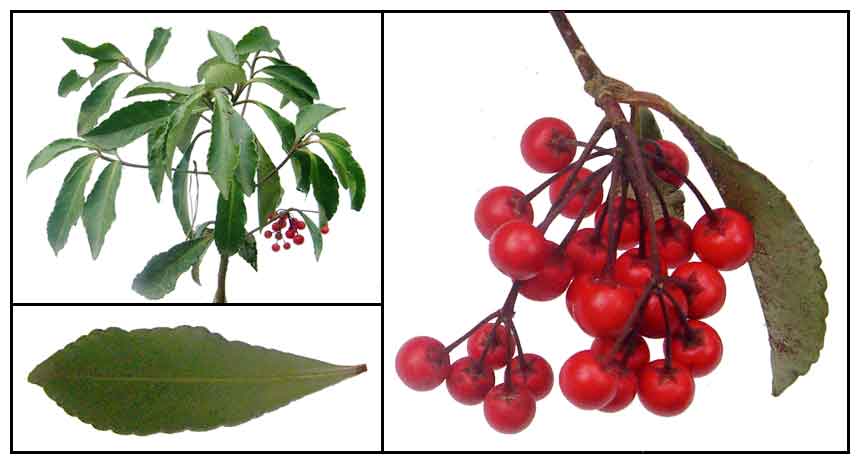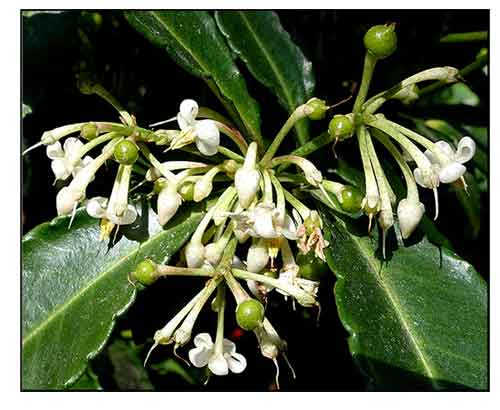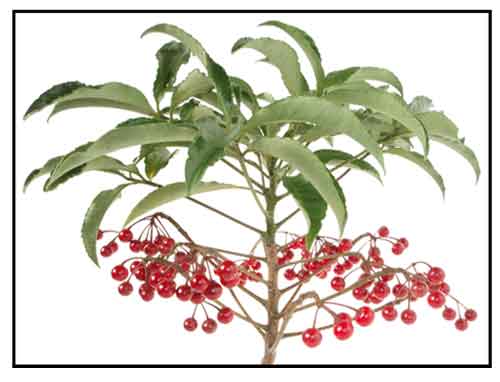
Gen info
• Ardisia is a genus of flowering plants in the family Primulaceae. It was formerly in the Myrsinaceae family, which is now recognized as the myrsine sub-family Myrsinoideae. There are over 700 accepted species, distributed in the Americas, Asia, Australia, and the Pacific Islands, mainly in the tropics. (27)
• Ardisia Sw. is the largest genus of the family Primulaceae with about 720 accepted species around the world. There are 74 species recorded in the Philippines, of which 62 are endemic.
•Etymology: The genus name Ardisia derives from Greek ardis, meaning 'a point', referring to the pointed anthers of the plant. The species epithet crenata derives from Latin, meaning 'cut in rounded scallops', referring to the shape of the leaf blade margins. (26)
 Botany Botany
• Coral berry is an evergreen glabrous shrub with many branches, growing to a height of 1.5 meters. Leaves are alternate, simple, dark green, leathery, elliptic lanceolate or oblanceolate with crenate or undulate margins. Flowers are small, white or pink. Fruit is a drupe, coral red and single-seeded.
• A shrub or treelet up to 3.0 m tall. Foliage: Alternate, stalked leaves have thinly leathery leaf blades that are oval or narrowly lance-shaped, or narrowly drop-shaped, 5–60 by 1.9–4 cm, and the margins are crenate, with distinctly scalloped edges. Flowers: Its flowering clusters are stalkless or stalked, and found at the ends of the twigs. Its stalked flowers are white or rarely pinkish, and about 8.5 mm wide, with pointed anthers. Fruit: Round fruits are shiny, bright-red, and 5–8 mm wide. (26)
Distribution
- Native to the Philippines.
-
Cultivated in gardens for its decorative red fruits.
- A popular pot plant.
- Also native to Assam, Cambodia, China South-Central, China Southeast, Hainan, India, Japan, Korea, Laos, Malaya, Myanmar, Nansei-shoto, Sri Lanka, Taiwan, Thailand, Tibet, Vietnam. (13)
- In some countries, considered an invasive weed.
- Invasive in the United States where it was introduced in the early 20th century, and escaped cultivation in 1982.
 Constituents Constituents
- Study yielded nine compounds: 5-hydroxymethyl-2-furalclehyde(1), ethyl-beta-D-fructopyranoside(2), syringic acid(3), n-butyl-beta-D-fructofuranoside(4), n-butyl-alpha-D-fructofuranoside(5), methyl-alpha-D-fructofuranoside(6), (+)-bergenin(7), ardisiacrispins B(8), asperuloside acid(9). (see study below) (8)
-
Leaves yielded a novel cyclic depsipeptide, designated FR900359, with the molecule containing two cis peptide bonds. (9)
- Roots yielded four components: bergenin, friedlin, ß-sitosterol and rapanone. (15)
- Study of roots yielded two new triterpenoid saponins, ardisicrenoside K (1) and ardisicrenoside L (2). (see study below) (16)
- Study of roots isolated a bergenin derivative
determined to be 11-o-syringylbergenin, along with spinasterol, fatty acid series, ß-sitosterol-ß-D-glucoside, norbergenine, and sucrose. (20)
- Study isolated three new triterpenoid saponins, ardisicrenoside I (1), ardisicrenoside J (2), and ardisicrenoside M (3), along with eight known compounds, from the roots of Ardisia crenata Sims. (24)
- Study of roots isolated two novel triterpenoid saponins, ardisicrenoside C(1)[3β-O-{α-L-rhamnopyranosyl-(1→2)-β-D-glucopyranosyl-(1→4)-[β-D-glucopyranosyl-(1→2)]-α-L-arabinopyranosyl}-16α, 28-dihidroxy-olean-12-en-30-oic acid 30-O-β-D-glucopyranosyl ester] and ardisicrenoside D (2) [3β-O-{β-D-xylopyranosyl-(1→2)-β-D-glucopyranoxyl-(1→4)-[β-D-glucopyranosyl-(1→2)]-α-L-arabino-pyranosyl}-16α, 28-dihydroxy-olean-12-en-30-oic acid 30-O-β-D-glucopyranosyl ester]. (see study below) (28)
- HPLC study of roots isolated five compounds including one catechin and four bergenins, including 11-β-d-glucopyranosyl-bergenin and (−)-gallocatechin. (see study below) (29)
- Study of roots isolated two triterpenoid saponins, ardisicrenoside K (1) and ardisicrenoside L (2): 3β-O-{α-l-rhamnopyranosyl-(1 → 2)-β-d-glucopyranosyl-(1 → 4)-[β-d-glucopyranosyl-(1 → 2)]-α-l-arabinopyranosyl}-13β,28-epoxy-16-oxo-30,30-dimethoxyoleanane and 3β-O-{β-d-xylopyranosyl-(1 → 2)-β-d-glucopyranosyl-(1 → 4)-[β-d-glucopyranosyl-(1 → 2)]-α-l-arabinopyranosyl}-13β,28-epoxy-16α,20-dihydroxyoleanane. (30)
- Study of roots isolated two new triterpenoid saponins, ardisicrenoside R and S (1 and 2), one new phenylpropanoid glycoside, ardicrephenin (3), along with five known compounds (4-8). (see study below) (31)
- Study of roots isolated two new phenols, ardisiphenol I (1) and ardisiphenol J (2) along with three known compounds (3-5). (see study below) (34)
Properties
- Studies suggest anodyne, depurative, febrifugal, antidotal, anti-tumor, vasorelaxant, diuretic, anti-thrombin, hypotensive, broncho-relaxation, platelet aggregation inhibitory, anti-asthmatic, cytotoxicity, melanogenesis stimulatory, anticancer, anti-inflammatory properties.
Parts
utilized
Roots, leaves, juice.
Uses
Folkloric
• No folkloric medicinal use in the Philippines.
• Elsewhere, root is considered anodyne, depurative, febrifuge; used to stimulate blood circulation.
• In traditional Chinese medicine, roots used for treatment of tonsillitis, toothaches, arthralgia, respiratory infections, and menstrual disorders.
• In Kampung Bawong, Perak, West Malaysia, juice from crushed whole plant used to treat fever and earaches. (22)
• In Thailand, roots used in combination with other plants to treat menstrual pains.
(26)
Others
• Provides a dense canopy.
 Studies Studies
• Triterpenoid Saponins / Ardisiacrenoside / Cytotoxicity:
Study isolated two novel triterpenoid saponins – ardisicrenoside A and adrisicrenoside B – and two known triterpenoid saponins, ardisicrispins A and B. (1)
• Potential Source of Therapeutic Agents:
There are more than 500 species of Ardisia throughout the tropical and subtropical regions, several used as ornamentals, food and medicines. Species of Ardisia are rich in novel and biologically potent phytochemical compounds such as bergenin and ardisin. The report presents the potential of the genus as a source of therapeutic agents. (2)
• Bergenin / Pharmacologic Activities / Roots:
Study isolated a new bergenin derivative from the root of A crenata – 11-o-syringylbergenin. Other compounds identified were spinasterol, fatty acids, beta-sitosterol-beta-D-glucoside, norgergenin and sucrose. (3) Study isolated four components from the roots of A. crenata: bergenin, friedelin, β-sitosterol and rapanone. Friedelin was isolated for the first time. (12) Studies have shown bergenin to possess a wide range of biological activities: antiulcer, hepatoprotective, antiviral, antidiabetic, anti-inflammatory, among others. (•) Study reports on the optimization of extraction process of bergenin from roots of A. crenata by response surface methodology. (23)
• Ardisiacrispin A and B / Pro-Apoptotic / Anticancer:
Study investigating the anticancer activity of ardisiacrispin A+B on several human cancer lines showed it could inhibit the proliferation of Bel-7402 cells by inducing apoptosis and dissembling microtubule. (4)
• Anti-Thrombin Activity:
In a study of 30 plants from central Florida for its antithrombin activity, Ardisia crenata was one of seven that demonstrated activity of 80% or higher in a chromogenic bioassay system. (6)
• Ardisiacrenoside / Cytotoxic Triterpenoid: Ardisiacrenoside, a new triterpenoid pentasaccharide was isolated from A crenata with five closely related triterpenoid saponins. Their cytotoxic activities were evaluated against human tumor cell lines. (7)
• Anti-Tumor Metastasis:
Study evaluated the anti-tumor metastatic constituents from Ardisia crenata. Study yielded nine compounds: 5-hydroxymethyl-2-furalclehyde(1), ethyl-beta-D-fructopyranoside(2), syringic acid(3), n-butyl-beta-D-fructofuranoside(4), n-butyl-alpha-D-fructofuranoside(5), methyl-alpha-D-fructofuranoside(6), (+)-bergenin(7), ardisiacrispins B(8), asperuloside acid(9). The isolated compounds (1-9) showed positive anti-tumor metastatic activities, and compounds 1, 5, and 8 showed significant anti-tumor metastatic activities. (8)
• Depsipeptide FR900359 / Leaves:
FR900359, isolated from leaves, was found to inhibited platelet aggregation in rabbits, decrease blood pressure and induce hypotension in anesthetized, normotensive rats. (11)
• Antibacterial:
An ethanol extract of A. crenata exhibited significant antibacterial activity against α-streptococcus hemolyticus, ß-streptococcus hemolyticus and Staphylococcus aureus in vitro. (11)
• Stimulation of Melanogenesis in Melanoma Cells:
Study evaluated the effect of a methanol extract of Ardisia crenata on melanogenesis in B16F10 cells. Treatment of cultured B16F10 cells with extract showed concentration dependent increase in melanin levels, without cytotoxicity. There was also increase in protein expression of microphthalmia-associated transcription factor. AC stimulated melanogenesis by increasing tyrosinase expression via inhibition of ERK and Akt. Results suggest a potential in the treatment of hypopigmentation diseases and skin tanning cosmetic products. (14)
• Triterpenoid Saponins / Weak Antifungal / Roots: Study of roots yielded two new triterpenoid saponins, ardisicrenoside K (1) and ardisicrenoside L (2). In vitro study showed the compounds to have weak antifungal activity against plant pathogenic fungus Pyricularia oryzae. (16)
• Ardicrenin: Study reports on the new, effective, and economical method of extraction of ardicrenin from Ardisia crenata. Ardicrenin is considered a potential pharmaceutical. The research puts emphasis on the large scale isolation of one single saponin adicrenin of high purity fit for industrial production. (17)
• In the News: Asthma
Treatment: Researchers at the University of Bonn have extracted a pharmaceutical compound from the leaves of Ardisia crenata that offers new hope for asthmatics. FR900359. isolated from the leaves of coral berry. was found to inhibit critical signaling Gq protein molecules. The compound almost completely inhibits the charateristic contraction of airways in a mice model of asthma. (18)
• Airway Relaxation in Asthma / Targeted Inhibition of Gq Signaling: A hallmark feature of obstructive lung disease is aberrant activation of Gq protein-dependent signaling cascades. Study hypothesized that pharmacological Gq inhibition could be a central mechanism to achieve efficient therapeutic bronchorelaxation. (19)
• Vasorelaxant Effect / Cyclic Depsipeptide: A cyclic depsipeptide, FR900359, isolated from A. crenata was evaluated for vasorelaxant effect on rat aortic arteries. The compound caused concentration-dependent relaxation in phenylephrine-precontracted endothelium-intact aortic rings, which was inhibited by addition of L-NMMA, a NOS inhibitor. Results suggest the vasorelaxant effect is mediated through the increase release of NO from endothelial cells, and can be attributed to inhibitory effects on voltage-dependent Ca(2+) channel and receptor-operated Ca(2+) channel-dependent Ca(2+) influx at high concentrations. (21)
• Triterpenoid Saponins / cAMP Phosphodiesterase Inhibitory Activity Effect / Roots: Study of roots isolated two novel triterpenoid saponins. The isolated saponins along with their prosapogenins and sapogenins have been evaluated for inhibitory activity on cAMP phosphodiesterase as a primary screening test for new medical compounds. (see constituents above) (28)
• Antimicrobial Molecules / Roots: HPLC study of roots isolated five compounds including one catechin and four bergenins. Among these, 11-β-d-glucopyranosyl-bergenin and (−)-gallocatechin showed potential inhibition for Staphylococcus aureus and Pseudomonas aeruginosa with MIC of 0.26 and 0.33 mg/mL, respectively. Molecular docking results showed 11-β-d-glucopyranosyl-bergenin had a better affinity for Casein lytic proteinase P (ClpP), and (−)-gallocatechin possessed a strong affinity for LasA hydrolysis protease and LasB elastase. Study suggest catechin and bergenins from A. crenata can be used as antimicrobial activity molecules. (29)
• Cytotoxicity against Cancer Cell Lines / Ardicrenin / Roots: Study of roots isolated two new triterpenoid saponins, ardisicrenoside R and S (1 and 2), one new phenylpropanoid glycoside, ardicrephenin (3), along with five known compounds (4-8). Compounds 2-7 were evaluated for cytotoxic activities against A549, MCF-7, HepG2 and MDA-MB-231 cell lines by MTT assay. Ardicrenin (6) showed significant cytotoxicity with IC50s of 1.17, 1.19, 3.52, and 16.61 µmol/l, respectively. (31)
• Benzoquinone Variability in Red and White Fruit Varieties / Cytotoxic Activity: Study evaluated the bioactive profiles of two different varieties of A. crenata fruits, red- and white-berried. The roots of red-berried A. crenata contain bioactive benzoquinones such as embelin and rapanone. Cytotoxic activity against human melanoma and prostate cancer cells was evaluated. White-berried variety showed profoundly higher content of rapanone, 606.5 mg/100g d.w., compared to red crenata at 16.2 mg/100 g d.w. Embelin was found in minor amounts in both varieties. (32)
• Ardisiacrispin A from Red and White Varieties / Cytotoxicity against Cancer Cell Lines: Pharmacologic activity is attributed to triterpene saponins, including ardisiacrispin A. Study calculated ardisiacrispin A in different parts of both red- and white-berried varieties. Yields showed 22.17 and 25.72 mg/g d.w. in roots 2.64 and 3.43 mg/g d.w. in fruits of red- and white-berried ardisia, respectively. Cytotoxicity assessment of ardisiacrispin A and A. crenata extracts on a panel of human cancer cell lines revealed similar effect of root extracts from both varieties, with highest potency against melanoma WM793 and colon cancer Caco2. Results suggest the white-berried variety may serve as substitute for red-berried ardisia and serve as alternative source of plant material rich in bioactive saponins. (33)
• Antibacterial / Roots: Study of roots isolated two new phenols, ardisiphenol I (1) and ardisiphenol J (2) along with three known compounds (3-5). Compound 5 showed moderate antibacterial activity against Enterococcus faecalis. (34)
• Anticancer / Head and Neck Squamous Cell Carcinoma (HNSCC): Ardisia crenata has shown effect in inhibition of tumor cells by regulating cell cycle and inducing apoptosis. Study investigated the potential mechanism of A. crenata anti-HNSCC based on network pharmacology, molecular docking, and invitro experiments. 163 common target genes were identified as candidate targets for treatment of HNSCC, with top core targets of TP53, GAPDH, AKT1, STAT3, CCND1 and SRC. Analysis indicated A. crenata exerted anti-HNSCC effects mainly through pathways in cancer, prostate cancer, neuroactive ligand-receptor interaction, P13K-Akt signaling pathway, p53 signaling pathway, EGFR tyrosine kinase inhibitor resistance and endocrine resistance. Ardisia crenata could effectively inhibit proliferation of FaDu cells, and down-regulate the expression of p-P13K and p-AKT. Study demonstrated multi-targets and multi-pathways in the treatment of HNSCC. (35)
• Anti-Inflammatory / Lactone / Leaves: Study of leaves isolated a new lactone, Ardisicreolide C (1), together with three saponin compounds, Ardisiacrispin B (2), Ardisicrenoside A (3), Ardisiacrispin A (4). The anti-inflammatory effect of Ardisicreolide C (1) was evaluated by ELISA method. Ardisicreolide C could reduce release of nitric oxide (NO), tumor necrosis factor (TNF-α), interleukin 1ß (IL-1ß), IL-4, and IL-10 of the cell supernatant to exert anti-inflammatory activity. (36)
Availability
- Wild-crafted.
- Roots, seeds, and herbal supplements in the cybermarket. |

![]()




 Botany
Botany

